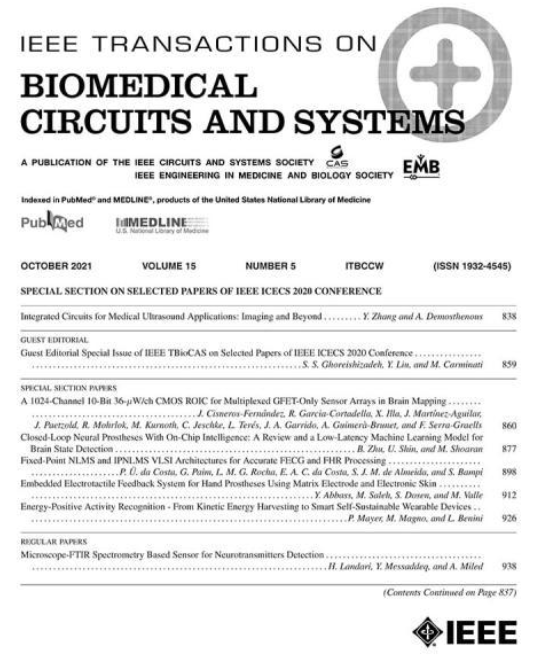多技术可重构电化学生物传感器:在移动设备中实现个人健康监测
IF 4.9
2区 医学
Q2 ENGINEERING, BIOMEDICAL
IEEE Transactions on Biomedical Circuits and Systems
Pub Date : 2016-10-01
DOI:10.1109/TBCAS.2016.2586504
引用次数: 51
摘要
本文描述了一种可重构的多技术电化学生物传感器的设计和特性,该传感器设计用于直接集成到智能手机和可穿戴技术中,以实现远程和准确的个人健康监测。通过将组件从一种模式转换为另一种模式,生物传感器的恒电位器能够将自身重新配置为三种不同的测量模式,以最小的冗余设备执行安培,电位和阻抗光谱测试。该模块的3.9 × 1.65 cm2的PCB原型是用分立元件开发的,并使用谷歌的Project Ara模块化智能手机进行了测试。安培模式测量范围为±1na ~±200 μA。当用于检测pH值时,电位模式的分辨率为<;0.08 pH单位。在阻抗测量模式下,该设备可以测量50 Ω-10 MΩ,并已证明具有<;6°相位误差。该原型被用于执行适合移动设备使用的几个护理点健康跟踪分析:1)进行了血糖测试,并显示其覆盖了糖尿病患者的诊断范围(~200 mg/dL)。2)乳铁蛋白是尿路感染的生物标志物,检测限约为1 ng/mL。3)通过汗液pH值测试来追踪运动过程中的脱水情况。4) EIS法无标记法测定NeutrAvidin的浓度。本文章由计算机程序翻译,如有差异,请以英文原文为准。
A Multi-Technique Reconfigurable Electrochemical Biosensor: Enabling Personal Health Monitoring in Mobile Devices
This paper describes the design and characterization of a reconfigurable, multi-technique electrochemical biosensor designed for direct integration into smartphone and wearable technologies to enable remote and accurate personal health monitoring. By repurposing components from one mode to the next, the biosensor's potentiostat is able reconfigure itself into three different measurements modes to perform amperometric, potentiometric, and impedance spectroscopic tests all with minimal redundant devices. A 3.9 × 1.65 cm2 PCB prototype of the module was developed with discrete components and tested using Google's Project Ara modular smartphone. The amperometric mode has a ±1 nA to ±200 μA measurement range. When used to detect pH, the potentiometric mode achieves a resolution of <; 0.08 pH units. In impedance measurement mode, the device can measure 50 Ω-10 MΩ and has been shown to have <; 6° of phase error. This prototype was used to perform several point-of-care health tracking assays suitable for use with mobile devices: 1) Blood glucose tests were conducted and shown to cover the diagnostic range for Diabetic patients (~200 mg/dL). 2) Lactoferrin, a biomarker for urinary tract infections, was detected with a limit of detection of approximately 1 ng/mL. 3) pH tests of sweat were conducted to track dehydration during exercise. 4) EIS was used to determine the concentration of NeutrAvidin via a label-free assay.
求助全文
通过发布文献求助,成功后即可免费获取论文全文。
去求助
来源期刊

IEEE Transactions on Biomedical Circuits and Systems
工程技术-工程:电子与电气
CiteScore
10.00
自引率
13.70%
发文量
174
审稿时长
3 months
期刊介绍:
The IEEE Transactions on Biomedical Circuits and Systems addresses areas at the crossroads of Circuits and Systems and Life Sciences. The main emphasis is on microelectronic issues in a wide range of applications found in life sciences, physical sciences and engineering. The primary goal of the journal is to bridge the unique scientific and technical activities of the Circuits and Systems Society to a wide variety of related areas such as: • Bioelectronics • Implantable and wearable electronics like cochlear and retinal prosthesis, motor control, etc. • Biotechnology sensor circuits, integrated systems, and networks • Micropower imaging technology • BioMEMS • Lab-on-chip Bio-nanotechnology • Organic Semiconductors • Biomedical Engineering • Genomics and Proteomics • Neuromorphic Engineering • Smart sensors • Low power micro- and nanoelectronics • Mixed-mode system-on-chip • Wireless technology • Gene circuits and molecular circuits • System biology • Brain science and engineering: such as neuro-informatics, neural prosthesis, cognitive engineering, brain computer interface • Healthcare: information technology for biomedical, epidemiology, and other related life science applications. General, theoretical, and application-oriented papers in the abovementioned technical areas with a Circuits and Systems perspective are encouraged to publish in TBioCAS. Of special interest are biomedical-oriented papers with a Circuits and Systems angle.
 求助内容:
求助内容: 应助结果提醒方式:
应助结果提醒方式:


